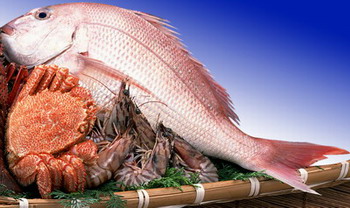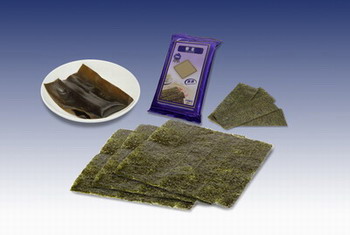
Food Safety Focus (61st Issue, August 2011) – Incident in Focus
Have You Taken Enough Iodine?
Reported by Dr. Violette LIN, Scientific Officer
Risk Assessment Section, Centre for Food Safety
Contrary to popular belief, iodine deficiency can occur in highly developed countries or coastal areas where seafoods are abundant, such as those in Mainland China and in Australia. Studies found that individuals living in areas with severe iodine deficiency could have intelligence quotient (IQ) of up to 13.5 points below those in areas without such problems.
Iodine Intakes at Global and Local Levels
World Health Organizatin (WHO) released a report in 2007 which estimated insufficient iodine intakes in 31% of the world's population. Of these, those in South-East Asia, pregnant/lactating women, and infants/young children are the most vulnerable ones. The Hong Kong Expert Panel Group on Iodine Deficiency Disorders, formed by local academics and experts, also in 2003 examined local data and considered borderline iodine deficiency exists in some local expectant mothers.
| WHO Recommended Iodine Intake (μg/day) | |
|---|---|
| Preschool children (0 to 59 months) | 90 |
| Schoolchildren (6 to 12 years) | 120 |
| Adolescents (above 12 years) and adults | 150 |
| Pregnant and lactating women | 250 |
To understand the local situation, the Centre for Food Safety (CFS) sampled local food and assessed the Dietary Iodine Intake in Hong Kong Adults in 2009. The consumption data was obtained from the Hong Kong Population- based Food Consumption Survey 2005-2007. The report released last month revealed a median iodine intake of 44 μg/day and 93% of the adult population with intake below WHO's recommendation.
Meeting the Dietary Iodine Requirement
While updated clinical and biochemical (e.g. urinary iodine level) data would help to further evaluate the actual human effects, the findings provide some evidence that there is a need for the public to become better aware about their own iodine intake. A note of caution: patients with underlying thyroid diseases and those who are used to very low intakes of iodine for a prolonged period should consult their doctors and are not suggested to increase iodine intake suddenly.
Those who are in the vulnerable groups should consider meeting their dietary iodine requirement by the following approaches:
( 1 ) Consume Foods High in Iodine
Human body actually needs only a small amount but regular daily intake of iodine (see WHO recommended iodine intake). When ingested in large amounts, iodine is readily excreted through the kidneys into the urine. While excessive iodine intake for a long time may disrupt the thyroid gland's normal functions, healthy adults can safely tolerate an intake up to 1 000 μg/day.
The public is advised to include foods that are rich in iodine in their dietary choice and take precautions to reduce iodine loss as iodine may dissolve in water during cooking. To retain its maximum amount, try to steam or stir-fry foods with little oil, and cook clean crustaceans intact.
| Foods rich in iodine ( μg/kg ) as found in the abovesaid CFS study included the following: | |
|---|---|
| Dried kelp and laver | 8 900 – 2 600 000 |
| Seaweed snack and nori sheet for sushi | 6 400 – 38 000 |
| Shellfish and marine water fish | 32 – 2 100 |
| Dairy products | 40 – 1 400 |
Including iodine rich foods in the diet such as (a) shellfish and marine water fish, and (b) seaweeds helps to meet iodine requirement.
( 2 ) Use of Iodised Salt in the Diet
WHO has recommended iodised salt as the solution for countries where iodine deficiency is of public health concern. Iodised salt is not yet widely available in Hong Kong though around 70% of households throughout the world have access to it.
Regarding the quantity, WHO considered that replacing 5 grams of ordinary salt from all sources in an adult's diet with iodised ones each day is generally safe. This will add an extra 100 to 200 μg of iodine to the daily diet, if the salt is fortified according to WHO's recommendation at 20 to 40 mg iodine per kg of salt. The actual increase in intake may vary, and likely lower, depending on the use of iodised salt in food premises or other processed foods.
When used in domestic setting, iodised salt should be stored in a tight and coloured container at a cool dry place and preferably added immediately before the food is served. It is because the iodine contained in iodised salt is generally unstable and may be lost due to humidity and exposure to heat and sunlight.
Key Points to Note:
- Insufficient iodine intake is a global health concern.
- Seaweeds and seaweed products, shellfish and dairy products are rich in iodine.
- WHO recommends using iodised salt to replace table salt to prevent iodine deficiency.
Advice to Consumers
- Include iodine rich foods as part of a balanced diet.
- Steam or stir-fry foods with little oil, and cook clean crustaceans intact to retain the maximum amount of iodine in foods.
- Replace table salt with iodised salt, the consumption of which should be kept below 5 grams per day from all sources .
Advice to the Trade
- Make iodised salt available to the public.
- Provide proper labelling of iodised salt, such as instructions on its usage to minimise its iodine loss.
- Declare the amount of iodine on the label of iodised salt.



